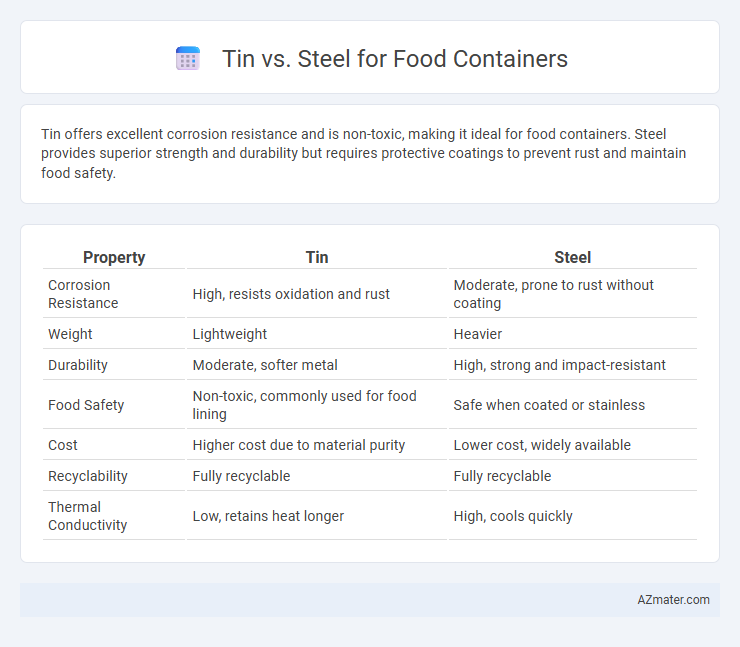Tin offers excellent corrosion resistance and is non-toxic, making it ideal for food containers. Steel provides superior strength and durability but requires protective coatings to prevent rust and maintain food safety.
Table of Comparison
| Property | Tin | Steel |
|---|---|---|
| Corrosion Resistance | High, resists oxidation and rust | Moderate, prone to rust without coating |
| Weight | Lightweight | Heavier |
| Durability | Moderate, softer metal | High, strong and impact-resistant |
| Food Safety | Non-toxic, commonly used for food lining | Safe when coated or stainless |
| Cost | Higher cost due to material purity | Lower cost, widely available |
| Recyclability | Fully recyclable | Fully recyclable |
| Thermal Conductivity | Low, retains heat longer | High, cools quickly |
Introduction: Comparing Tin and Steel for Food Containers
Tin and steel are both popular materials used for food containers due to their durability and ability to preserve food quality. Tin offers excellent corrosion resistance and a non-toxic surface, making it ideal for direct contact with food, while steel provides superior strength and structural integrity, suitable for heavy-duty storage needs. Choosing between tin and steel depends on factors like food type, container usage, and desired longevity.
Material Composition of Tin and Steel
Tin, primarily composed of the metal tin (Sn), is often used as a thin coating for steel containers to prevent corrosion and enhance food safety. Steel containers consist mainly of iron (Fe) alloyed with carbon (C) and other elements like chromium (Cr) and nickel (Ni) in stainless steel varieties to provide strength and resistance to rust. The combination of tin coating on steel ensures a durable, non-reactive surface suitable for preserving various food products without compromising container integrity.
Durability and Strength Differences
Steel food containers exhibit superior durability and strength compared to tin, making them more resistant to dents, corrosion, and heavy impacts. Tin containers often suffer from thinner walls and susceptibility to rust when exposed to moisture or acidic foods, reducing their lifespan. The enhanced tensile strength of steel ensures better structural integrity in food storage, especially under demanding conditions.
Food Safety and Chemical Reactivity
Tin food containers offer excellent corrosion resistance and minimal chemical reactivity, making them safe for acidic and oily foods without leaching harmful substances. Steel containers, especially stainless steel, provide strong durability and resistance to rust but can react with highly acidic or alkaline foods if not properly coated. Choosing tin or stainless steel containers depends on the specific food type and desired chemical inertness to ensure optimal food safety.
Corrosion and Rust Resistance
Tin offers superior corrosion resistance compared to steel, making it ideal for food containers that require long-term preservation without contamination. Steel, particularly untreated or low-grade variants, is prone to rust when exposed to moisture and acidic foods, compromising food safety and container integrity. Coated steel containers with tin plating combine the strength of steel with the corrosion resistance of tin, providing an optimal solution for durable, rust-resistant food storage.
Weight and Portability Considerations
Steel food containers generally weigh more than tin options, impacting portability, especially for on-the-go use. Tin containers offer a lighter alternative, making them preferable for packing lunches or travel meals without adding significant weight. Both materials provide durability, but tin excels where reduced weight and ease of transport are priorities.
Cost and Affordability Analysis
Tin containers generally have higher manufacturing costs due to the expense of tinplate production and corrosion-resistant coatings, making them less affordable for large-scale food packaging. Steel containers, especially those made from carbon steel, offer a more cost-effective solution with lower material costs and ease of mass production, enhancing affordability for food manufacturers. While tin provides superior corrosion resistance, steel's economical price point makes it the preferred choice for budget-conscious food container applications.
Environmental Impact and Recyclability
Tin containers offer a lightweight and corrosion-resistant option with high recyclability rates, as tin can be repeatedly recycled without significant quality loss. Steel containers, particularly stainless steel, provide durability and resistance to rust, with steel being one of the most recycled materials globally, contributing to lower environmental impact due to reduced raw material extraction. Both materials support sustainable packaging solutions, but steel's extensive recycling infrastructure and longer lifecycle often result in a smaller carbon footprint over time compared to tin.
Common Uses in the Food Packaging Industry
Steel is widely used in food packaging for canned vegetables, soups, and meats due to its strength and excellent barrier properties, preventing contamination and extending shelf life. Tin, often used as a coating for steel cans, provides corrosion resistance and enhances the safety and durability of food containers, especially for acidic foods like tomatoes and fruits. Both materials are integral in food packaging, with steel offering structural integrity and tin providing protection against rust and chemical reactions.
Conclusion: Choosing the Ideal Metal Food Container
Tin offers excellent corrosion resistance and is lightweight, making it suitable for short-term food storage. Steel provides superior durability and strength with better resistance to dents and impact, ideal for long-term and heavy-duty use. Selecting between tin and steel depends on the specific requirements of food preservation, usage frequency, and container longevity.

Infographic: Tin vs Steel for Food Container
 azmater.com
azmater.com